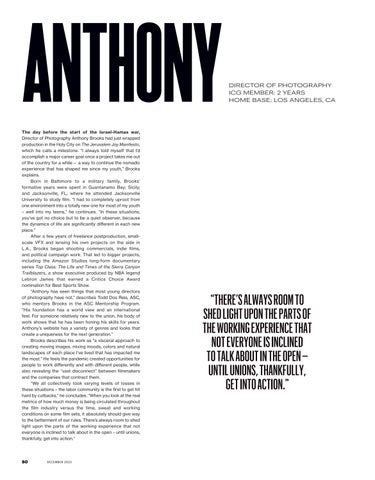ANTHONY The day before the start of the Israel-Hamas war, Director of Photography Anthony Brooks had just wrapped production in the Holy City on The Jerusalem Joy Manifesto, which he calls a milestone. “I always told myself that I’d accomplish a major career goal once a project takes me out of the country for a while – a way to continue the nomadic experience that has shaped me since my youth,” Brooks explains. Born in Baltimore to a military family, Brooks’ formative years were spent in Guantanamo Bay; Sicily; and Jacksonville, FL; where he attended Jacksonville University to study film. “I had to completely uproot from one environment into a totally new one for most of my youth – well into my teens,” he continues. “In these situations, you’ve got no choice but to be a quiet observer, because the dynamics of life are significantly different in each new place.” After a few years of freelance postproduction, smallscale VFX and lensing his own projects on the side in L.A., Brooks began shooting commercials, indie films, and political campaign work. That led to bigger projects, including the Amazon Studios long-form documentary series Top Class: The Life and Times of the Sierra Canyon Trailblazers, a show executive produced by NBA legend Lebron James that earned a Critics Choice Award nomination for Best Sports Show. “Anthony has seen things that most young directors of photography have not,” describes Todd Dos Reis, ASC, who mentors Brooks in the ASC Mentorship Program. “His foundation has a world view and an international feel. For someone relatively new to the union, his body of work shows that he has been honing his skills for years. Anthony’s website has a variety of genres and looks that create a uniqueness for the next generation.” Brooks describes his work as “a visceral approach to creating moving images, mixing moods, colors and natural landscapes of each place I’ve lived that has impacted me the most.” He feels the pandemic created opportunities for people to work differently and with different people, while also revealing the “vast disconnect” between filmmakers and the companies that contract them. “We all collectively took varying levels of losses in these situations – the labor community is the first to get hit hard by cutbacks,” he concludes. “When you look at the real metrics of how much money is being circulated throughout the film industry versus the time, sweat and working conditions on some film sets, it absolutely should give way to the betterment of our rules. There’s always room to shed light upon the parts of the working experience that not everyone is inclined to talk about in the open – until unions, thankfully, get into action.”
80
D EC E M B E R 20 2 3
DIRECTOR OF PHOTOGRAPHY ICG MEMBER: 2 YEARS HOME BASE: LOS ANGELES, CA
“THERE’S ALWAYS ROOM TO SHED LIGHT UPON THE PARTS OF THE WORKING EXPERIENCE THAT NOT EVERYONE IS INCLINED TO TALK ABOUT IN THE OPEN – UNTIL UNIONS, THANKFULLY, GET INTO ACTION.”
